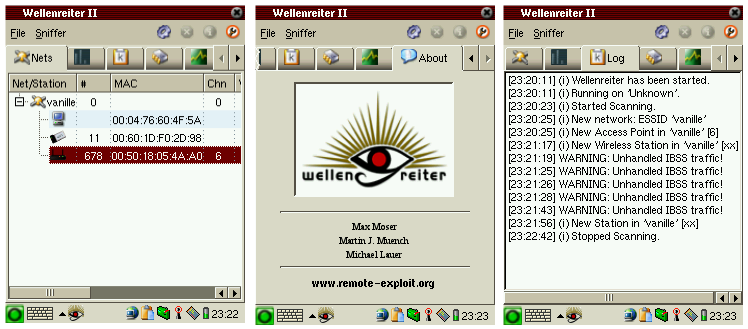KisMAC – a WiFi scanner for your Mac Free and open-source program helps you collect essential information about surrounding WiFi networks. KisMAC WiFi scanner app can detect SSIDs, shows you the logged in clients, allows you to sketch WiFi maps, and more! Download KisMAC 2 source code. KisMAC is an open-source and free stumbler/scanner application for Mac OS X. It has an advantage over MacStumbler / iStumbler / NetStumbler in that it uses monitor mode and passive scanning. KisMAC supports several third party PCMCIA cards: Orinoco, PrismII, Cisco Aironet, Atheros and PrismGT. KisMAC is a free, open source wireless stumbling and security tool for Mac OS X. IGRSoft/KisMac2. Kismet drone support (capture from a Kismet drone) Supported hardware chipsets. Apple AirPort and AirPort Extreme (dependent upon Apple's drivers) Intersil Prism 2, 2.5, 3 USB devices Ralink rt2570 and rt73 USB devices Realtek RTL8187L USB (such as the Alfa AWUS036H, which does not work on Mac OS 10.6.7 or later) Crypto support.
| Developer(s) | Mike Kershaw (dragorn) |
|---|---|
| Stable release | 2020-04-R3[1] / May 2, 2020; 5 months ago |
| Repository | |
| Written in | C++ |
| Operating system | Cross-platform |
| Type | Packet Sniffer |
| License | GPL |
| Website | www.kismetwireless.net |
Kismet is a network detector, packet sniffer, and intrusion detection system for 802.11wireless LANs. Kismet will work with any wireless card which supports raw monitoring mode, and can sniff 802.11a, 802.11b, 802.11g, and 802.11n traffic. The program runs under Linux, FreeBSD, NetBSD, OpenBSD, and Mac OS X. The client can also run on Microsoft Windows, although, aside from external drones (see below), there's only one supported wireless hardware available as packet source.
Distributed under the GNU General Public License,[2] Kismet is free software.
Features[edit]
Kismet differs from other wireless network detectors in working passively. Namely, without sending any loggable packets, it is able to detect the presence of both wireless access points and wireless clients, and to associate them with each other. It is also the most widely used and up to date open source wireless monitoring tool.[citation needed]
Kismet also includes basic wireless IDS features such as detecting active wireless sniffing programs including NetStumbler, as well as a number of wireless network attacks.

Kismet features the ability to log all sniffed packets and save them in a tcpdump/Wireshark or Airsnort compatible file format. Kismet can also capture 'Per-Packet Information' headers.
Kismet also features the ability to detect default or 'not configured' networks, probe requests, and determine what level of wireless encryption is used on a given access point.
In order to find as many networks as possible, Kismet supports channel hopping. This means that it constantly changes from channel to channel non-sequentially, in a user-defined sequence with a default value that leaves big holes between channels (for example, 1-6-11-2-7-12-3-8-13-4-9-14-5-10). The advantage with this method is that it will capture more packets because adjacent channels overlap.
Kismet also supports logging of the geographical coordinates of the network if the input from a GPS receiver is additionally available.
Server / Drone / Client infrastructure[edit]
Kismet has three separate parts. A drone can be used to collect packets, and then pass them on to a server for interpretation. A server can either be used in conjunction with a drone, or on its own, interpreting packet data, and extrapolating wireless information, and organizing it. The client communicates with the server and displays the information the server collects.
Plugins[edit]
With the updating of Kismet to -ng, Kismet now supports a wide variety of scanning plugins including DECT, Bluetooth, and others.
Kismet For Mac Os High Sierra
Usage[edit]
Kismet is used in a number of commercial and open source projects. It is distributed with Kali Linux.[3] It is used for wireless reconnaissance,[4] and can be used with other packages for an inexpensive wireless intrusion detection system.[5] It has been used in a number of peer reviewed studies such as 'Detecting Rogue Access Points using Kismet'.[6]
See also[edit]
- KisMAC (for Mac OS X)
References[edit]
- ^https://www.kismetwireless.net/ Kismet web site
- ^'Kismet Readme'. kismetwireless.net. Retrieved 2008-02-22.
- ^'Kismet'. Kali Tools. Kali Linux.
- ^Lynn, Michael; Biondi, Philippe; Beauchesne, Nicolas (August 2007). Security Power Tools. O'Reilly Media. Retrieved 9 March 2016.
- ^Murray, Jason. 'An Inexpensive Wireless IDS using Kismet and OpenWRT'. SANS Institute. Retrieved 9 March 2016.
- ^Thejdeep, G. (2015). 'Detecting Rogue Access Points using Kismet'. In Communications and Signal Processing: 0172–0175. doi:10.1109/ICCSP.2015.7322813. ISBN978-1-4799-8081-9.
External links[edit]
Kismet is a wireless network and device detector, sniffer, wardriving tool, and WIDS (wireless intrusion detection) framework.
Kismet works with Wi-Fi interfaces, Bluetooth interfaces, some SDR (software defined radio) hardware like the RTLSDR, and other specialized capture hardware.

Kismet works on Linux, OSX, and, to a degree, Windows 10 under the WSL framework. On Linux it works with most Wi-Fi cards, Bluetooth interfaces, and other hardware devices. On OSX it works with the built-in Wi-Fi interfaces, and on Windows 10 it will work with remote captures.
Kismet 2020-09-R4 released!
Kismet 2020-09-R4 is the latest bugfix release for the 2020-09 releases, with only one minor bugfix to the datasources panel.
Check it out on the Kismet downloads page and read more about the release

Kismet features the ability to log all sniffed packets and save them in a tcpdump/Wireshark or Airsnort compatible file format. Kismet can also capture 'Per-Packet Information' headers.
Kismet also features the ability to detect default or 'not configured' networks, probe requests, and determine what level of wireless encryption is used on a given access point.
In order to find as many networks as possible, Kismet supports channel hopping. This means that it constantly changes from channel to channel non-sequentially, in a user-defined sequence with a default value that leaves big holes between channels (for example, 1-6-11-2-7-12-3-8-13-4-9-14-5-10). The advantage with this method is that it will capture more packets because adjacent channels overlap.
Kismet also supports logging of the geographical coordinates of the network if the input from a GPS receiver is additionally available.
Server / Drone / Client infrastructure[edit]
Kismet has three separate parts. A drone can be used to collect packets, and then pass them on to a server for interpretation. A server can either be used in conjunction with a drone, or on its own, interpreting packet data, and extrapolating wireless information, and organizing it. The client communicates with the server and displays the information the server collects.
Plugins[edit]
With the updating of Kismet to -ng, Kismet now supports a wide variety of scanning plugins including DECT, Bluetooth, and others.
Kismet For Mac Os High Sierra
Usage[edit]
Kismet is used in a number of commercial and open source projects. It is distributed with Kali Linux.[3] It is used for wireless reconnaissance,[4] and can be used with other packages for an inexpensive wireless intrusion detection system.[5] It has been used in a number of peer reviewed studies such as 'Detecting Rogue Access Points using Kismet'.[6]
See also[edit]
- KisMAC (for Mac OS X)
References[edit]
- ^https://www.kismetwireless.net/ Kismet web site
- ^'Kismet Readme'. kismetwireless.net. Retrieved 2008-02-22.
- ^'Kismet'. Kali Tools. Kali Linux.
- ^Lynn, Michael; Biondi, Philippe; Beauchesne, Nicolas (August 2007). Security Power Tools. O'Reilly Media. Retrieved 9 March 2016.
- ^Murray, Jason. 'An Inexpensive Wireless IDS using Kismet and OpenWRT'. SANS Institute. Retrieved 9 March 2016.
- ^Thejdeep, G. (2015). 'Detecting Rogue Access Points using Kismet'. In Communications and Signal Processing: 0172–0175. doi:10.1109/ICCSP.2015.7322813. ISBN978-1-4799-8081-9.
External links[edit]
Kismet is a wireless network and device detector, sniffer, wardriving tool, and WIDS (wireless intrusion detection) framework.
Kismet works with Wi-Fi interfaces, Bluetooth interfaces, some SDR (software defined radio) hardware like the RTLSDR, and other specialized capture hardware.
Kismet works on Linux, OSX, and, to a degree, Windows 10 under the WSL framework. On Linux it works with most Wi-Fi cards, Bluetooth interfaces, and other hardware devices. On OSX it works with the built-in Wi-Fi interfaces, and on Windows 10 it will work with remote captures.
Kismet 2020-09-R4 released!
Kismet 2020-09-R4 is the latest bugfix release for the 2020-09 releases, with only one minor bugfix to the datasources panel.
Check it out on the Kismet downloads page and read more about the release
Help support Kismet
Always Open Source
There are several ways you can help support Kismet development financially if you'd like to; support is always appreciated but never required. Kismet is, and always will be, open source.
Github
Kismet can be sponsored via the GithHub Sponsorship program, and for the first year, GitHub matches donations made by sponsors!
Patreon
Kismet has a Patreon page at https://www.patreon.com/kismetwireless.
Amazon
Need some hardware? Here's some we've had good luck with, and Amazon gives a small kickback if you order through the links.
IRC and Discord
If you'd like to chat with the Kismet community, you can find us:
- On Discord, at the Discord Kismet server
- On IRC, at the #kismet channel on irc.freenode.net
Hardware and Cases
If you'd like to help out supporting Kismet dev and have a Raspberry Pi 0w, Ubertooth One, or Yardstick One that needs some Kismet love (or just protection from getting smashed in your bag), you can get acrylic cut cases at the Kismet Tindie Store.
Shirts and swag
Need some geeky shirts to show your wireless love? We've got some at the Kismet Teespring store.
Development
Kismet is under near-continual development. If you're interested in the latest cutting-edge code, check out the Kismet Git repository, either at:
or to checkout from the Github mirror:
You can follow the development on Kismet and related projects via the Developer Posts and on Twitter via @KismetWireless
Kismet plugins
With the new Kismet codebase (Kismet-2018-Beta1 and newer), Kismet supports plugins which extend the WebUI functionality via Javascript and browser-side enhancements, as well as the more traditional Kismet plugin architecture of C++ plugins which can extend the server functionality at a low level. Kismet also supports external ‘helper tools' which can extend server functionality via scripting tools such as Python.
Kestrel
Kestrel adds live mapping to the Kismet UI using the Leaflet library, and overlays network and device locations on a live map with pin grouping for dense areas.
You can find Kestrel at https://gitlab.com/SoliForte777/Kestrel and see a video of it in action
IoD - Screwdriver
More and more devices are getting 'smart' functionality, including 'personal' devices. Screwdriver from IoD highlights devices advertising more than you might prefer.
Get the IoD screwdriver plugin here
Optimized mobile interface
A re-spin of the Kismet web UI by ElKentaro optimized for mobile devices like phones and tablets, which makes seeing information from Kismet at a glance much simpler.
The mobile dashboard is on Github here
Kismet report generator
A report generator for grouping devices by BSSID or SSID, with an export to PDF and CSV.
Kismet For Mac Os 10.10
You can find Soliforte's report generator here
Working on a plugin?
If you're working on a Kismet plugin you'd like to share, let us know on IRC, the Kismet Discord server or @KismetWireless on Twitter.
